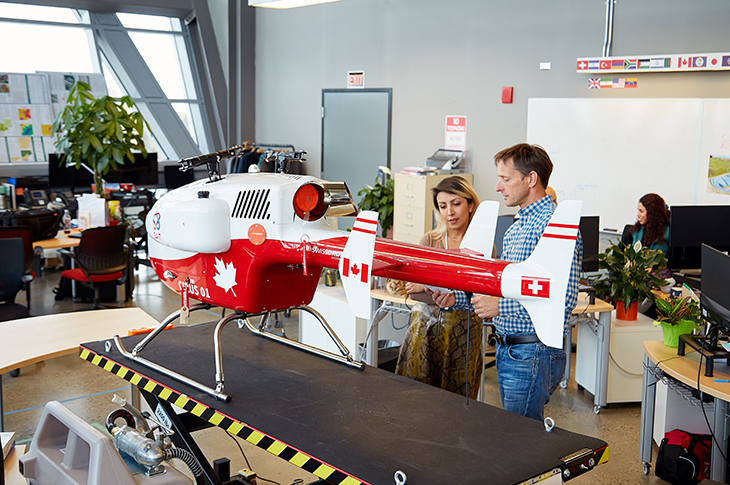SAIT students level up with drone lab

Drones go back a lot further than you might expect — with the first unmanned air vehicles developed during the First World War. It took a while for them to evolve and become mainstream, but hobbyists and researchers alike now have access to high-tech drones. The question is, what are we going to do with them?
Wade Hawkins is the Principal Investigator for the Centre for Innovation and Research in Unmanned Systems (CIRUS), part of SAIT’s Applied Research and Innovation Services division, and he’s spent a lot of time answering that question by stepping out of the lab and taking a look in the classroom.
“I was a faculty instructor in SAIT’s School of Construction for nearly 15 years before I moved into a research secondment with CIRUS,” Hawkins says. “A colleague and I recognized early on the need for drone technology in the various disciplines within the school. I taught in the Bachelor of Applied Technology, Geographic Information Systems (BGIS) program, so there was a direct pipeline to this kind of tech for capturing and analyzing data related to the earth’s surface.”
SAIT’s hands-on approach includes a program that gives students the opportunity to work on real-world problems and funnel their learning into a solution.
“In their second semester, BGIS students do a capstone project. We’ve had 30 or 40 students through the lab in the last few years. We help facilitate the capstone projects, and the students’ deliverables need to satisfy their industry client. We’ve had projects ranging from using drones to enhance mining operations to delivery of medical supplies. Students have the opportunity to incorporate their own innovations into industry before they even graduate,” says Hawkins.
It’s a chance to help create real solutions for real problems.
“The company I’m working with, Teck, requires a solution for vegetation monitoring in mining reclamation areas. My group’s project is focused on the analysis of multispectral images with high resolution to explore higher-level options, particularly in terms of species identification and vegetative height,” says Rose Simancas, BGIS student.
“CIRUS has GIS software specialists in the lab to help direct our ideas and analysis.”
Having SAIT students work on these projects in CIRUS’ lab and with its expert researchers creates a highly qualified learner pipeline for industry. Their credentials have weight — with SAIT being named a top five research college in Canada.
“We like to hire our practicum students because we know they’ll have the skills we’re looking for, but sometimes we can’t offer fast enough before they’re scooped up by someone else,” says Hawkins.
What does the CIRUS lab mean for SAIT students?
Outside of the real-world experience and working alongside skilled researchers, students in programs across SAIT benefit from the developments in drone technology and its applications coming out of the lab.
“A lot of what we do at CIRUS is cutting edge and research-focused, and we take those learnings and share them with instructors in the program. For example, the procedures to detect wildlife or lost persons using a drone-mounted thermal sensor,” says Hawkins.
“Program instructors incorporate these procedures and data it into their curriculum. Students are learning about these new applications from the source. It gives them an edge when they start their careers.”
Ready to innovate before you even leave the classroom?
Industry Driven
We prepare students for successful careers and lives.
SAIT'S
2020-2025
Strategic plan

Oki, Âba wathtech, Danit'ada, Tawnshi, Hello.
SAIT is located on the traditional territories of the Niitsitapi (Blackfoot) and the people of Treaty 7 which includes the Siksika, the Piikani, the Kainai, the Tsuut’ina and the Îyârhe Nakoda of Bearspaw, Chiniki and Goodstoney.
We are situated in an area the Blackfoot tribes traditionally called Moh’kinsstis, where the Bow River meets the Elbow River. We now call it the city of Calgary, which is also home to the Métis Nation of Alberta.